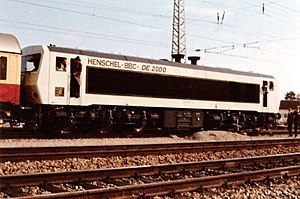Henschel-BBC DE2500
This article includes a list of references, related reading, or external links, but its sources remain unclear because it lacks inline citations. (December 2014) |
| DB Class 202 | |||||||||||||||||||||||||||||||||||||||
|---|---|---|---|---|---|---|---|---|---|---|---|---|---|---|---|---|---|---|---|---|---|---|---|---|---|---|---|---|---|---|---|---|---|---|---|---|---|---|---|
 DB 202 002 | |||||||||||||||||||||||||||||||||||||||
| |||||||||||||||||||||||||||||||||||||||
| |||||||||||||||||||||||||||||||||||||||
| |||||||||||||||||||||||||||||||||||||||
| |||||||||||||||||||||||||||||||||||||||
The DB Class 202, also commonly referred to under its manufacturers' designation Henschel-BBC DE2500, since it was only in experimental use and never purchased by the DB, is a class of diesel-electric locomotives designed for use on main and secondary lines for both passenger and freight trains.
One unit was converted to 1.5 kV DC operation under electric catenary, and used for evaluation by the Nederlandse Spoorwegen, as NS Class 1600P.
History
[edit]The class represents a major milestone in the German locomotive development, since these are the first locomotives to have three phase asynchronous electric traction applied in a mainline diesel-electric locomotive.
The DE2500 featured a light-weight and completely modular construction, which allowed the quick and easy exchange of whole sections of the locomotive, such as the prime mover, generator or alternator sections. It was both capable of driving on Co'Co' bogies (002, 004) as well as Bo'Bo' bogies (003). All the components of the electric sections - from generator to traction motors - were built to the latest state of the art featuring brushless, collectorless and nearly contactless operation, which resulted in long service intervals and high reliability.
The locomotives were extensively tested by the Deutsche Bundesbahn on its lines throughout Western Germany, starting in 1971 through the mid-1980s. They were stationed at Bw Mannheim with the following DB numbers:
- 202 002-2 (white)
- 202 003-0 (orange, later UmAn paint scheme)
- 202 004-8 (blue)
Conversion to electric locomotive
[edit]During the mid-1970s, locomotive 202-002 was converted for the Dutch Railways (NS) into an all-electric locomotive for 1.5 kV DC-overhead wire. It was painted in the Dutch yellow scheme, assigned the number 1600P and given the logos of the Dutch railways. A pantograph for the collection of the current from the overhead wire was installed, the diesel prime mover and the generator section were removed and replaced with ballast weight. The NS was very pleased with the results of the test cycles, but ultimately chose to acquire its serial-production Class 1600 from French manufacturers, based on the BB 7200, for both budget and delivery time considerations.
Test-run in Denmark
[edit]The Danish State Railways, DSB, tested the locomotive 202 004. The later acquired DSB Class ME, though heavier and stronger (115 t, 3.300 hp), were based on these prototypes. 37 of the class were built.
Models
[edit]
An H0 scale model engine has been made of the BR 202 by the German company Heris.
Literature
[edit]- Matthias Maier (1997), Diesellokomotiven deutscher Eisenbahnen (in German), Düsseldorf: alba
- Markus Hehl, Eisenbahn-Kurier Special : Deutsche Diesellokomotiven (in German), Freiburg: EK-Verlag
- Karl Gerhard Baur: Die Geschichte der Drehstromlokomotiven. EK-Verlag, Freiburg, 2005. ISBN 3-88255-146-1
- BBC Asynchronous motor drive for Diesel locomotives Order No. D VK 40810 E
- Horst J. Obermayer: Diesellokomotiven - Mit Kleinlokomotiven, Stuttgart 1972.
- Pages using the JsonConfig extension
- Diesel locomotives of Germany
- Deutsche Bundesbahn locomotives
- Diesel–electric locomotives of Germany
- Bo′Bo′ locomotives
- Co′Co′ locomotives
- Railway locomotives introduced in 1971
- Henschel locomotives
- Brown, Boveri & Cie locomotives
- Standard gauge locomotives of Germany
- Standard gauge locomotives of the Netherlands

